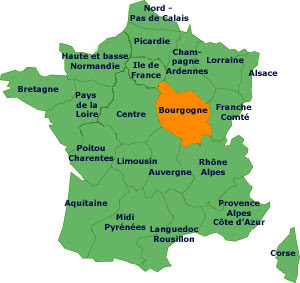Burgundy's Cote D'Or is home to some of the priciest cult wines on earth
Many serious wine
lovers believe that some of the world’s greatest wines come from Burgundy. Others would argue that Bordeaux is
the pinnacle. I don’t think you can
compare the two. Burgundy’s production
is miniscule; Bordeaux’s is
mammoth. Burgundy is boutique producers; Bordeaux is large-scale chateaux. Burgundy’s wines are quietly elegant; Bordeaux’s are bold and massively-structured.
History
The famous Cluny Abbey played an important role in Burgundy
The Catholic monks,
abbeys, and the monasteries have played an enormous role in shaping Burgundy’s
wine history. From 900 A.D., the clergy
were actively involved in not only making and selling wine, but actually
developing the notion of terroir (soil, microclimate, slant of the hill, drainage, wind, environmental pests, etc.). Early
on they learned that different plots of earth made consistently different
wines.
Centuries ago monks surrounded vineyards with special characteristic with walls
The monks mapped out an
intricately complex quilt of vineyards throughout Burgundy which today are the basis
for the region's Cru’s. They built walls
around each plot. Wall in French is “clos,”
thus many of Burgundy’s vineyards begin with the word “clos.”
Location
In French Burgundy is known as Bourgogne
Burgundy begins just
120 miles south of Paris. The actual wine part of the region is a long,
narrow area that runs about 150 miles in length. Burgundy is composed of these five distinct sub-districts (north to south):
1)
Chablis
2)
Cote
D’Or
3)
Cote
Chalonaise
4)
Maconnaise
5)
Beaujolais
Two Great Grapes of Burgundy
Reds in Burgundy
are made from Pinot Noir (the only exception is Beaujolais which uses the Gamay grape). Difficult to grow, fickle Pinot Noir thrives
in a narrow band of soil and climate parameters. Red Burgundy is mecca for many oenophiles. In fact, many in-the-know consumers feel that
Pinot Noir is at its very best in Burgundy.
White Burgundy is made
a 100% from the Chardonnay grape. The Chardonnay
varietal is actually is native to the Burgundian region of France. While Chardonnay is a now a universal grape,
white Burgundies are some of the most divine wines on planet earth---complex layers with a long finish.
Burgundy is Terroir-Driven
Every plot of earth has been painstaking rated for the quality of its terroir
Unlike Bordeaux
where the pecking order is established by a chateau’s land holdings, Burgundy’s
hierarchy is purely terroir based. For
example, Mouton Rothchild in Bordeaux owns many parcels in different parts
of the huge wine region. All of them may be
used in the making Rothschild's wine as Bordeaux wines are all about blending. In Burgundy, vineyards have been carefully mapped out into very small plots based on their unique
terroir. In contrast to Bordeaux, Burgundy "Cru" cannot be blended as their intent is to showcase the specific single vineyard and its terroir.
Stay tuned for
future articles on Burgundy, including Pinots and Chardonnays that
won’t break your bank, pairing Burgundy's wine with foods, and many other favorite experiences of mine awaiting you in Burgundy.





No comments:
Post a Comment